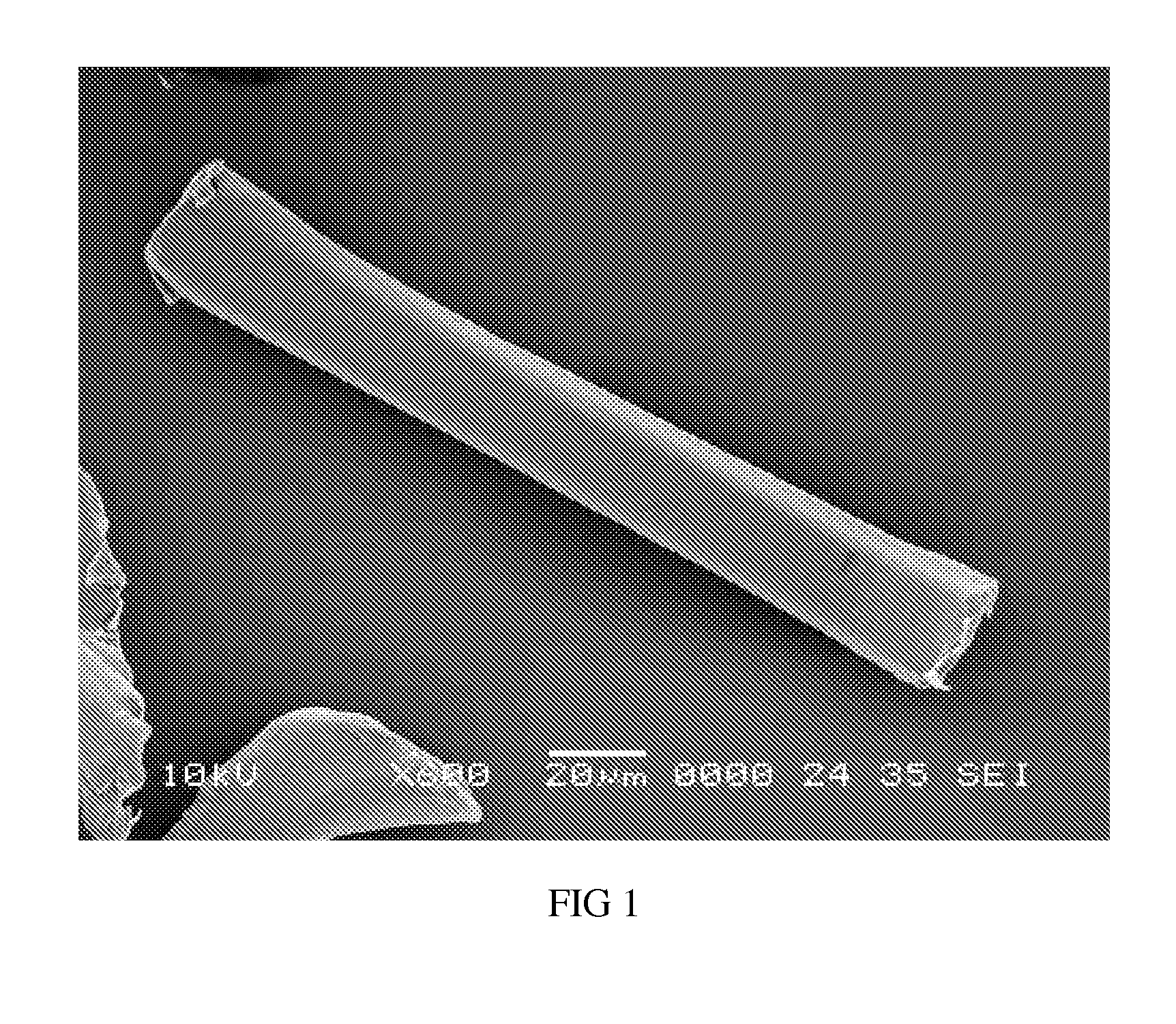Method of making hydrophilic fluoropolymer material
a technology of hydrophilic fluoropolymer and fluoropolymer material, which is applied in the direction of gas current separation, solid separation, grain milling, etc., can solve the problems of difficulty in wetness, chemically etched fluoropolymer surface tend to lose bond strength, temperature, humidity and uv light have a detrimental effect on etched surface, etc., to increase the surface area and roughness of fluoropolymer materials, increase the hydrophilic rate rate rate rate rate rate rate rate ra
- Summary
- Abstract
- Description
- Claims
- Application Information
AI Technical Summary
Benefits of technology
Problems solved by technology
Method used
Image
Examples
example 1
[0044]In Example 1, the virgin floe was cut into lengths of approximately 200 to 250 microns. As displayed in FIGS. 1 through 4, the virgin floe fibers had smooth, nearly featureless exterior surfaces along the lengths thereof. The ends of the floc fibers were substantially smooth and nearly featureless as well, with the exception of the PTFE floc fibers shown in FIG. 4, which exhibited some uneven areas which arc believed to have resulted from the cutting process.
[0045]The wettability of the 200 to 250 microns virgin PTFE fiber floe was tested. In a first test, 50 grams of the floc and 200 ml of deionized water were placed into a Waring blender and mixed for 30 seconds. Thereafter, the mixture was observed. Immediately, the PTFE floc fibers that were not adhered to the walls of the blender or floating on top of the water began to settle to the bottom of the blender. This resulted in the formation of three distinct mixture portions including a floc rich bottom portion, a water rich ...
example 2
[0048]In Example 2, the virgin floc was cut into lengths of approximately 6350 microns. As displayed in FIG. 5, the virgin floc fibers had smooth, nearly featureless exterior surfaces along the lengths thereof. These figures further show that floc fibers tended to clump together.
[0049]The wettability of the 6350 microns virgin PTFE fiber floc was tested. Fifty grams of the floc and 200 ml of deionized water were placed into a Waring blender and mixed for 30 seconds. Thereafter, the mixture was observed. Immediately, the PTFE floc fibers began to settle to the bottom of the container. This resulted in the formation of two distinct mixture portions including a floc rich bottom portion and a water rich top portion The test results evidenced that the 6350 microns PTFE fiber floc was hydrophobic.
example 3
[0050]In Example 3, a portion of the 200 to 250 microns virgin PTFE fiber floc was processed by jet milling and examined. As shown in FIGS. 6 through 14, jet mill processing of the fluoropolymer fiber floc modified the physical appearance of the fluoropolymer fibers. The modifications included surface deformations caused by tearing of the fibers. The tearing resulted in the formation of split fiber ends, slits along the bodies of the fibers, and formation of outwardly extending, fibril-like members and the exposure of interior surfaces of the fibers. The exposed interior surfaces of the fibers exhibited a grain that in certain instances, where a split resulted in the removal of an entire side of the fiber, extended the entire length of the fibers. The grain appeared to be formed by the fibril-like members.
[0051]The majority of the fibril-like members remained fully coupled to the fiber surfaces after tearing thus providing the exposed interior surfaces with a number of longitudinall...
PUM
| Property | Measurement | Unit |
|---|---|---|
| depth | aaaaa | aaaaa |
| depth | aaaaa | aaaaa |
| lengths | aaaaa | aaaaa |
Abstract
Description
Claims
Application Information
 Login to View More
Login to View More - R&D
- Intellectual Property
- Life Sciences
- Materials
- Tech Scout
- Unparalleled Data Quality
- Higher Quality Content
- 60% Fewer Hallucinations
Browse by: Latest US Patents, China's latest patents, Technical Efficacy Thesaurus, Application Domain, Technology Topic, Popular Technical Reports.
© 2025 PatSnap. All rights reserved.Legal|Privacy policy|Modern Slavery Act Transparency Statement|Sitemap|About US| Contact US: help@patsnap.com



